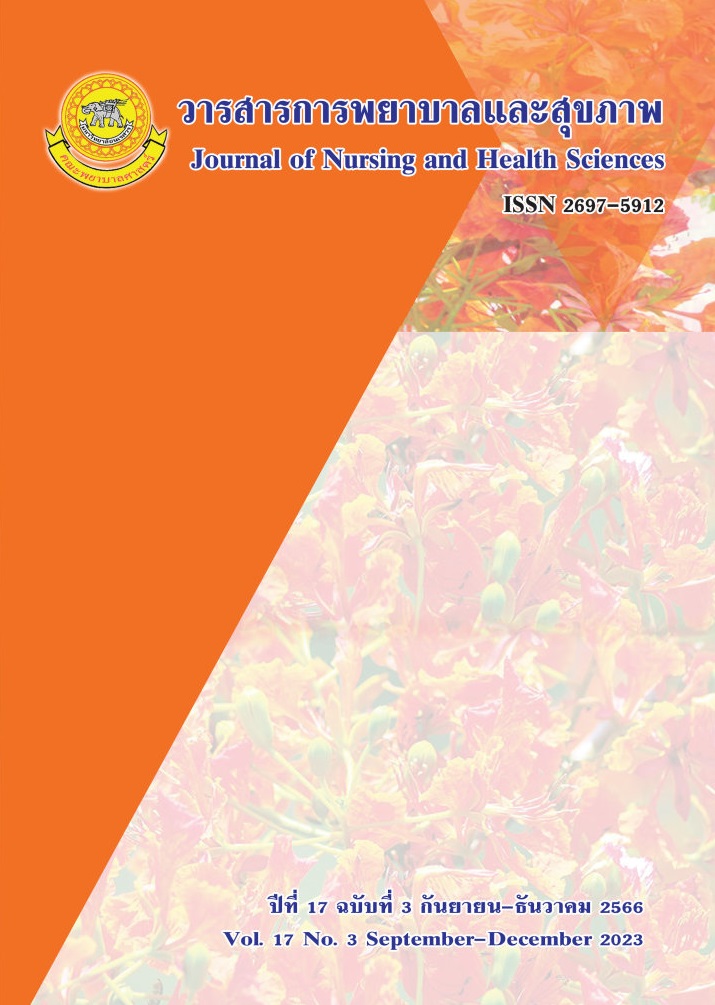การพัฒนาแบบประเมินคุณลักษณะเชิงเทคโนโลยีของแอปพลิเคชันในสมาร์ทโฟน สำหรับการติดตามการเดิน/วิ่งและกิจกรรมทางกายในวัยผู้ใหญ่
Main Article Content
บทคัดย่อ
แนวโน้มของการใช้งานแอปพลิเคชันในสมาร์ทโฟนด้านสุขภาพและสมรรถภาพในวัยผู้ใหญ่เพิ่มขึ้นอย่างต่อเนื่อง โดยคุณลักษณะเชิงเทคโนโลยี (Technological feature) ของแต่ละแอปพลิเคชันมีความสำคัญอย่างมากต่อการสร้างแรงจูงใจเพื่อเพิ่มการมีกิจกรรมทางกายให้กับผู้ใช้งาน แต่ยังไม่พบว่ามีแบบประเมินที่ใช้ในการตรวจสอบคุณลักษณะดังกล่าวที่สอดคล้องกับการเปลี่ยนแปลงทางเทคโนโลยีที่รวดเร็วในปัจจุบัน การศึกษานี้จึงมีวัตถุประสงค์เพื่อพัฒนาแบบประเมินเพื่อสำรวจคุณลักษณะเชิงเทคโนโลยีของแอปพลิเคชันในสมาร์ทโฟนสำหรับการติดตามการเดิน/วิ่งและกิจกรรมทางกายในวัยผู้ใหญ่สำหรับปฏิบัติการแอนดรอยด์ (Android) และระบบปฏิบัติการไอโอเอส (iOS) เพื่อทำให้ทราบคุณลักษณะเชิงเทคโนโลยีของแอปพลิเคชันในสมาร์ทโฟนที่สนใจตามวัตถุประสงค์ของการใช้งาน เพื่อเป็นข้อมูลในการพิจารณาเลือกใช้แอปพลิเคชันที่เกี่ยวข้องสำหรับบุคลากรทางสุขภาพและผู้เชี่ยวชาญอื่นๆ ที่เกี่ยวข้อง โดยแบบประเมินฯที่ผู้วิจัยพัฒนาขึ้นประกอบด้วยข้อคำถามในประเด็นต่างๆ ใน 6 หมวดหมู่ ได้แก่ การวัดและการติดตาม ข้อมูลและการวิเคราะห์ข้อมูลการทำกิจกรรมทางกาย การรองรับและข้อมูลป้อนกลับ สังคม การแข่งขันและการเปรียบเทียบ และการติดต่อกับผู้เชี่ยวชาญในแอปพลิเคชัน ซึ่งมีค่าดัชนีความสอดคล้องอยู่ในระดับสูง (IOC = 0.86) และมีค่าสัมประสิทธิ์ สหสัมพันธ์ภายในชั้น (Interclass Correlation Coefficient: ICC) อยู่ในระดับดีเยี่ยม (ICC = 0.98) มีค่าความเชื่อมั่นภายในผู้ประเมิน (Intraclass Correlation Coefficient) อยู่ในระดับดีเยี่ยม (ICC = 0.98-0.99) และมีค่าความเชื่อมั่นระหว่างผู้ประเมิน
(Interclass Correlation Coefficient) อยู่ในระดับดีเยี่ยม (ICC = 0.98-0.99) การศึกษานี้สรุปได้ว่า แบบประเมินเพื่อสำรวจคุณลักษณะเชิงเทคโนโลยีของแอปพลิเคชันในสมาร์ทโฟนสำหรับการติดตามการเดิน/วิ่งและกิจกรรมทางกายในวัยผู้ใหญ่ที่พัฒนาขึ้นครั้งนี้มีคุณภาพสูง สามารถนำไปใช้เพื่อสำรวจข้อมูลเชิงเทคโนโลยีตามวัตถุประสงค์เพื่อช่วยส่งเสริมกิจกรรมทางกายตามบริบทที่ต้องการให้เกิดประโยชน์สูงสุดต่อไป
Article Details

อนุญาตภายใต้เงื่อนไข Creative Commons Attribution-NonCommercial-NoDerivatives 4.0 International License.
เอกสารอ้างอิง
Abolfotouh, M.A., BaniMustafa, A., Salam, M., Al-Assiri,
M., Aldebasi, B., & Bushnak, I. (2019). Use of
smartphone and perception towards the usefulness
and practicality of its medical applications among
healthcare workers in Saudi Arabia. BMC Health
Services Research, 19(1), 826.
Anderson-Bill, E. S., Winett, R. A., & Wojcik, J. R.
(2011). Social cognitive determinants of nutrition
and physical activity among web-health users
enrolling in an online intervention: the influence
of social support, self-efficacy, outcome expectations, and self-regulation. Journal of Medical
Internet Research, 13(1):e28.
Apptopia. (2022). The Most Downloaded Health &
Fitness Apps in H1 2022. Retrieved 24 May 2023
from https://blog.apptopia.com/sweatcoin-mostdownloaded-app-worldwide-h1-2022
Bauer, M., Glenn, T., Geddes, J., Gitlin, M., Grof, P.,
Kessing, L. V., … & Whybrow, P. C. (2020).
Smartphones in mental health: a critical review
of background issues, current status and future
concerns. International Journal of Bipolar
Disorders, 8, 1-19.
Bull, F. C., Al-Ansari, S. S., Biddle, S., Borodulin, K.,
Buman, M.P., Cardon, G., … & Willumsen, J.
F. (2020). World Health Organization 2020
guidelines on physical activity and sedentary
behaviour. British Journal of Sports Medicine,
(24), 1451-1462.
D'Addario, M., Baretta, D., Zanatta, F., Greco, A., &
Steca, P. (2020). Engagement features in physical
activity smartphone apps: focus group study with
sedentary people. JMIR mHealth and uHealth,
(11), e20460.
DeJong, A.F., Fish, P.N., & Hertel, J. (2021). Running
behaviors, motivations, and injury risk during
the COVID-19 pandemic: A survey of 1147
runners. PLoS One, 16(2), e0246300.
Department of Health, Ministry of Public Health.
(2021). Impact of Covid-19 Pandemic on
Physical Activity in 2021. Retrieved 15 March
from http://www.thaincd.com/2016/mediadetail.php?id=14116&tid=&gid=1-015-005.
[In Thai].
Department of Health, Ministry of Public Health.
(2020). Report on Working-Age Population
Health. Retrieved 26 January 2022 from https://
datahpc9.anamai.moph.go.th/group_sr/allfile/
pdf. [In Thai].
Hongsanun, W. & Insuk, S. (2019). Development of the
Thai mobile health apps rating scale (THARS).
Thai Journal of Pharmacy Practice, 11(1), 181-193.
[In Thai].
Karnjanapiboonwong, A., Kumwungsanga, P., &
Kaewtha S. (2019). Report on the prevalence of
NCDs Diabetes Hypertension and their risk
factors in 2019. Department of Disease Control,
Ministry of Public Health. [In Thai].
Kongchan, W. (2017). Interactive features in mobile
fitness applications and usage behavior of
millennial users. Journal of Communication and
Management NIDA, 3(1), 88-98. [In Thai].
Koo, T. K., & Li, M. Y. (2016). A guideline of selecting
and reporting intraclass correlation coefficients
for reliability research. Journal of Chiropractic
Medicine, 15(2), 155-163.
Market Business News. (2023). The Latest Trends in
Health and Fitness App Development. Retrieved
May 2023 from https://marketbusinessnews.
com/the-latest-trends-in-health-and-fitness-appdevelopment/327789/
Mollee, J. S., Middelweerd, A., Kurvers, R. L. & Klein,
M.C.A. (2017). What technological features are
used in smartphone apps that promote physical
activity? A review and content analysis. Personal
and Ubiquitous Computing, 21, 633-643.
Moses, J. C., Adibi, S., Shariful Islam, S. M.,
Wickramasinghe, N., & Nguyen, L. (2021).
Application of smartphone technologies in
disease monitoring: a systematic review.
Healthcare, 9(7), 889.
Nhusawia, K., Mattayakornb, K., Ruangthaia, R., &
Prachakula, W. (2022). Causal relationship
model for maintaining exercise behavior among
Thai university staff: Integration of transtheoretical
model and self-determination theory. Kasetsart
Journal of Social Sciences, 43(4), 883-890.
Pattanasombutsook, M. (2021). Validation of nursing
research reports and proper use of social science
research instruments in publishing. The Southern
College Network Journal of Nursing and Public
Health, 8(2), 189-204. [In Thai].
Phuekphan, P., Setchoduk, K., & Saiklang P. (2022).
The psychological impacts of COVID-19
pandemic on nursing students. Thai Journal of
Nursing, 71(4), 55-62. [In Thai].
Pomkai, N., Sangsawang, A., & Chulert, P. (2022).
Virtual Community for Active lifestyle. Retrieved
January 2023 from https://tpak.or.th/th/article/
[In Thai].
Ranney, M. L., Stettenbauer, E.G., Delgado, M. K., Yao,
K. A., & Orchowski, L. M. (2022). Uses of
mHealth in Injury Prevention and Control: a
Critical Review. Current Epidemiology Reports,
(4), 273-281.
Srisupak, R., Srisawangwong, P., Ratdhanadharm, P., &
Na-Sangiam. (2022). An innovative personal
healthcare mobile application for the elderly.
Faculty of Science and Technology, Rajabhat
Maha Sarakham University. [In Thai].
Tanachote, P. (2021). Case Study: Strategy of Strava
development, Favorite application of runners
as a new experience to exercise. Retrieved 9
January 2023 from https://thegrowthmaster.com/
case-study/strava. [In Thai].
Thansettakij Newspaper. (2021). Trends of Home
Exercise on Effect to Promote Health and
Fitness Applications. Retrieved 29 January 2023
from https://www.thansettakij.com/tech/497341.
[In Thai].
Velvetech. (2023). Mobile App Update: Why and How.
Retrieved 23 May 2023 from https://www.
velvetech.com/blog/mobile-app-update/.
Waltz, C.F., Strickland, O. & Lenz, E.R. (2010).
Measurement in nursing and health research.
New York: Springer Publishing Company.


